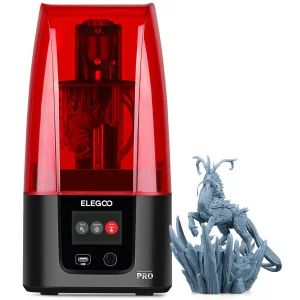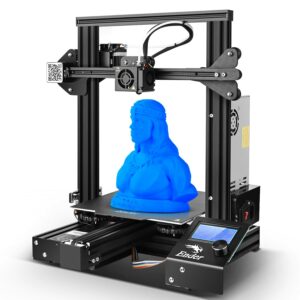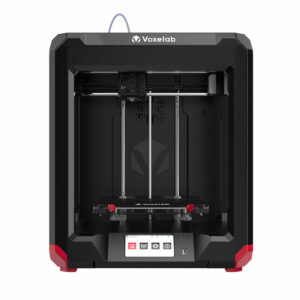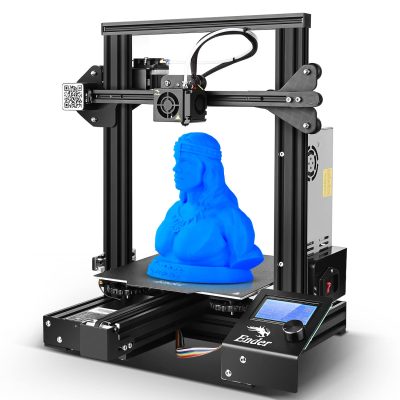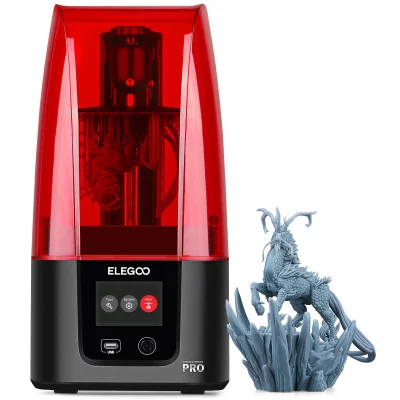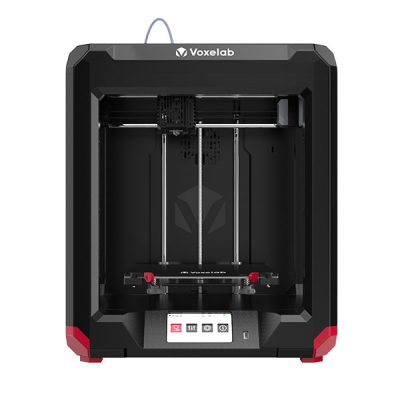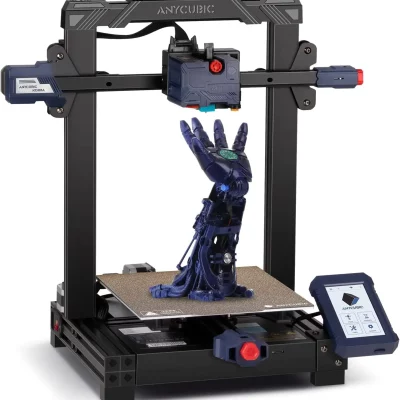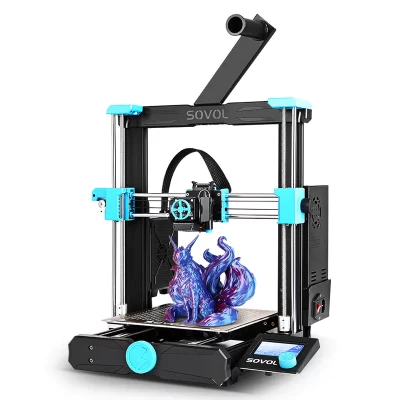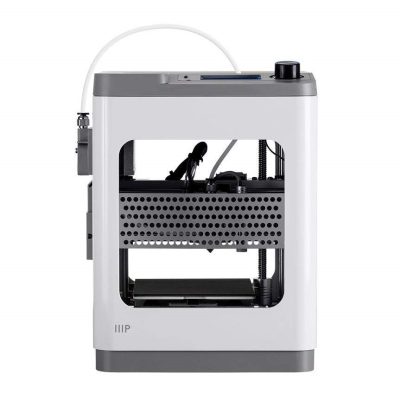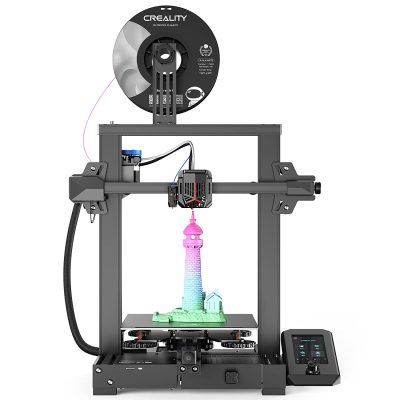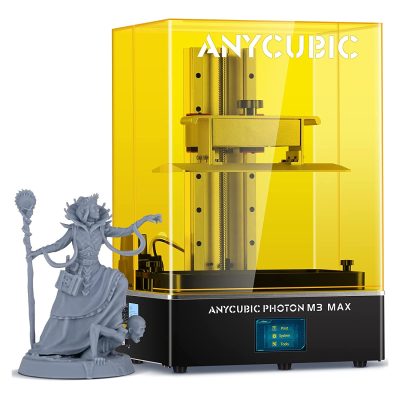- Last Updated: January 12, 2024
-
 Pat Nathaniel
Pat Nathaniel
You’ve long fantasized about 3D printers, but your eyes roll at the obnoxiously high prices.
You just wanna get on to making cool stuff, but you wonder – are there any affordable 3D printers that are actually any good? Or do I need to kidnap a person and get a ransom to pay for one?
No, don’t kidnap anyone!
We’ll tell you a legal way to get cool 3D printers for super affordable prices.
Whether that be a resin printer or a standard FDM printer (don’t worry if you don’t understand the 3D printing gibberish, we will explain this later), we’ve reviewed the best budget 3D printers under $300.
Let’s jump straight in!
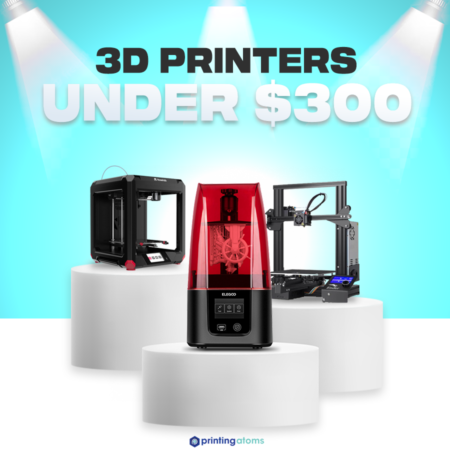

3D Printing Technology: SLA
Build Volume: 143 x 90 x 175 mm

3D Printing Technology: FDM
Build Volume: 220 x 220 x 250 mm
Top 8 3D Printers Under $300
1. Creality Ender 3 Pro (Best Choice)
2. Elegoo Mars 3 Pro (Best Value for Resin)
3. Voxelab Aries (Premium Choice)
4. Anycubic Kobra (Best Value for FDM)
5. Sovol SV06 (Best Material Range)
6. Monoprice Cadet (Best for Beginners)
7. Creality Ender 3 V2 Neo (Best Second 3D Printer)
8. Anycubic Photon M3
3D Printer Type: FDM | Layer Resolution: 0.1mm | Materials: PLA, ABS, PETG & TPU | Build Volume: 220 x 220 x 250 mm | Max Print Speed: 180 mm/s | Heated Bed Temperature: 110℃
This cool 3D printer has it all. It’s affordable, makes great prints, and is beginner-friendly. The Creality Ender 3 Pro is the complete package.
In spite of its affordability, the Ender 3 produces prints as good as 3D printers 3x its price.
However, you’ll have to tinker with the settings to dial it in. If you’re looking for a plug and play machine then skip the Ender and look at the next two options below. That said after your printer and software settings are dialed in, operating the printer is simple and straightforward.
One thing we like is the print bed is magnetic and can be removed easily after the 3D printing process. This bed is also flexible and you can remove prints without causing damage (just make sure you let the prints cool off though before removing them).
The Ender 3 Pro also comes with an open-source software (great for the nerdy among you) which you can tinker with to produce more intricate prints and complex prints. Not only that but you can add performance mods and quality of life upgrades to turn this little machine into a beast.
Speaking of little, the Ender 3 Pro has a low-profile and can be set on almost any desk in your house.
If you hate installing or building stuff, then setting up the Ender can be frustrating. You may find it challenging to put the pieces together if you are mechanically disinclined. No problemo, check the video below to help help you step-by-step A-Z through the whole process.
You can’t go wrong with the Creality Ender 3; it is one of the best budget 3D printers under $300, and we recommend it to everyone, both beginners and experts alike.
Note: there’s an upgraded version of the Ender 3 Pro called the Ender 3 V2 which is 10% larger, quieter with a silent motherboard, and has a coated glass build plate. If you have the extra $20 I would go for the V2 as just the quiet printing is worth it.
Pros
- Amazing value for the price
- Large community - very popular
- Printer operation is beginner friendly
- Easy to remove prints due to the flexible printing bed
Cons
- Can be difficult to assemble
- Bed leveling can be a pain
3D Printer Type: MSLA | Layer Resolution: 0.01 mm | Materials: DLP Photopolymer Resin | Build Volume: 143 x 90 x 175 mm | Max Print Speed: 50mm/h
A sub-$300 3D printer is already a great deal, but that doesn’t mean you shouldn’t aim to squeeze as much value out of your machine as possible. Elegoo Mars 3 Pro gives you more bang for your buck than most other 3D printers.
With a minimum layer height of only 10 microns, this resin printer is capable of extremely fine detail quality. Those looking to print intricate tabletop miniatures or other small, high-detail objects will not be disappointed.
Although it’s mostly plastic, Mars 3 Pro is solidly built. It doesn’t wobble and the sandblasted build plate adheres to prints very well (sometimes a bit too well). The welcome anti-scratch LCD screen cover makes damaging the screen accidentally very difficult, so you may save some money on spare parts.
This resin 3D printer comes pre-leveled and it’s ready to start printing straight out of the box. The touchscreen could be more responsive, but the clear UI makes operating Mars 3 Pro simple.
That said, you will likely have to spend some time dialing in the right settings. But once you find the sweet spot, expect reliable performance.
As a particularly nice touch, Mars 3 Pro comes with a plug-in air purifier. Resin fumes are toxic and the little active carbon-filled box does a surprisingly good job of reducing them. It doesn’t completely clean the air, though, so make sure to still run the machine in a well-ventilated area.
As the most significant downside, the print volume on Mars 3 Pro is pretty limited. It also requires you to use ChituBox, which may be good or bad — depending on your preferences in slicer software.
All in all, Elegoo Mars 3 Pro is a capable resin printer that punches well above its price tag.
Pros
- Great value for your money
- High detail quality
- Quick setup
- Air purifier
Cons
- Small build volume
- Bit of a learning curve
3D Printer Type: FDM | Layer Resolution: 0.01 mm | Materials: PLA, ABS & PETG | Build Volume: 200 x 200 x 200 mm | Max Print Speed: 180 mm/s | Heated Bed Temperature: 100℃
Voxelab Aries is marketed specifically to new 3D printer users — but the manufacturer is selling the machine short. This FDM 3D printer surpasses your expectations with premium performance.
In many ways, Aries is comparable to Creality Ender 3 Pro/V2. It offers identical layer resolution (0.1mm) and maximum printing speed (180mm/s). Its heated bed is slightly cooler and build volume a bit smaller than Creality’s but they’re still in the same class.
So what exactly makes Aries “premium?”
Try sheer performance. This printer makes 3D printing fast and reliable. You can save time without having to fiddle with the machine — and time is money.
Voxelab Aries is shipped pre-built and leveled. Just pull it out of the box, snip the zip ties holding components in place, remove protective films, and you’re ready to go. You’ll be hard-pressed to find a 3D printer with a more streamlined setup.
Unlike with most FDM printers, Aries’ nozzle doesn’t move on the Z axis. Instead, the print bed slowly lowers as the machine completes each layer. This unique mechanism results in reliably high print quality.
Aries also offers steady Wi-Fi connectivity. 3D printer Wi-Fi modules are notoriously temperamental, but that’s not the case here. Connect the machine to your Wi-Fi from its touchpad and you can fully control it without leaving your computer.
That is, if you use Voxelab’s VoxelMaker software. Although the Wi-Fi connectivity is great, the program is rather unreliable. Good thing Aries supports third-party software!
The machine is also very loud. As one user accurately put it, the cooling fan was probably a jet engine in a previous life. Get the Ender 3 V2 if silent printing is what you’re after.
You can afford earplugs if you buy this printer, though. Voxelab Aries performs like a much more expensive professional printer.
Pros
- Reliable performance
- High print quality
- Very fast setup
- Steady Wi-Fi connectivity
Cons
- Material range
- Loud
3D Printer Type: FDM | Layer Resolution: 0.1mm | Materials: PLA, ABS, PETG & TPU | Build Volume: 220 x 220 x 250 mm | Max Print Speed: 180 mm/s | Heated Bed Temperature: 110℃
Although Anycubic is best-known for its resin 3D printers, the company isn’t a one-trick pony. Anycubic Kobra shows it can also make a great FDM printer that provides excellent value for your money.
It’s pretty clear this machine is made to compete with the Creality Ender 3 Pro/V2. It has identical specs in every way and the printers even look more or less similar.
But make no mistake, Kobra is no cheap knockoff.
As a stand-out feature, this printer ships with auto-leveling as a standard feature. Say goodbye to painstakingly fumbling about with screws and Allen keys. This is a wonderful feature to have in a printer at this price point.
Additionally, Kobra uses a dual-gear extruder. This mechanism grips the filament firmly and reduces the likelihood of print errors. It follows that Kobra has very consistent print quality across print jobs.
With Kobra, you always know what you can expect.
Once your print is on the magnetic steel platform, it’s easy to remove it. Bending the removable, flexible print bed should pop the print right off without headaches or worries about breaking it.
Another nice goodie is the print resume function. In case you experience a power cut, you can smoothly continue printing after your lights come back on.
Like its Creality-branded competitor, this 3D printer doesn’t come pre-assembled. Anycubic says you can build the machine in 10 minutes, but that’s just not right (unless you’ve maybe assembled it before). Expect to spend a good 45 minutes setting up the machine.
The cooling fan at the print head is somewhat underpowered, which can lead to difficulties in printing thin surfaces. You can try to mitigate that by adjusting the printing temperature, though.
Considering all its more advanced features, Anycubic Kobra is a capable FDM printer at a good value.
Pros
- Auto-leveling
- Consistent print quality
- Good value for money
Cons
- Time-consuming assembly
- Slower than promised average print speed
- Underperforming cooling fan
3D Printer Type: FDM | Layer Resolution: 0.1 mm | Materials: PLA, ABS, PETG, Carbon Fiber, Nylon, ASA, PC & TPU | Build Volume: 220 x 220 x 225 mm | Max Print Speed: 80 mm/s | Heated Bed Temperature: 100℃
One of the biggest drawbacks of cheap 3D printers is their limited material support. It kind of makes sense, since cheaper parts often can’t cope with rough, advanced materials.
Unless you buy Sovol SV06, that is.
This FDM 3D printer can print with advanced filaments. It’s all thanks to the standard, all-metal direct drive extruder that doesn’t have the plastic tube that you usually find in sub-$300 machines. It can achieve hot end temperatures up to 300°C. Additionally, abrasive filaments won’t immediately wear down the extruder.
As a result, you have an extensive range of materials available to you. You can print with carbon fiber filaments to make durable, impact-resistant components — perhaps even spare car or machine parts.
The print quality is consistently good due to the extruder’s planetary gears that create higher torque than regular filament feed gears. In simpler words, the printer will reliably produce accurate, detailed prints.
Like the Anycubic Kobra, SV06 has a 25-point automatic bed leveling feature. Combine that with the simple assembly and you can go from box to printing in 30 minutes.
The simple setup and wide materials capabilities make SV06 a good option for both beginners and advanced users. Note, though, that you shouldn’t start printing with advanced materials. They are difficult to print and you could clog or even break the machine if you don’t know what you’re doing.
For all its great features, SV06 isn’t perfect. It has no runout sensor, so always make sure you have enough filament before you hit “Start.” Also, for some incomprehensible reason, the gears and bearings aren’t pre-lubricated so you’ll have to carefully grease them if you don’t want to listen to grinding.
But I’m picking nits really. This is a $300 3D printer that can print carbon fiber — what more could you want?
Pros
- All-metal nozzle supports advanced materials
- Simple assembly
- Great print quality
- Automatic bed leveling
Cons
- Printing advanced filaments is difficult
- No standard filament runout sensor
- Slow-ish print speed
3D Printer Type: FDM | Layer Resolution: 0.01 mm | Materials: PLA Only | Build Volume: 100 x 105 x 100 mm | Max Print Speed: 150 mm/s
Getting started with 3D printing can seem intimidating. But don’t worry — Monoprice Cadet is an excellent first stepping stone into the world of 3D printers.
The Cadet is aimed at new 3D printer users, whether they’re kids, students, or beginning hobbyists. It offers simple usability and good performance to help you get started.
This fully assembled machine is one of the few truly plug-and-play 3D printers. The setup process is straightforward and automated bed leveling makes calibration a breeze.
You can be up and ready to print in five minutes flat.
Printing quality-wise, the Cadet is comparable to any other FDM printer I’ve featured here. It creates surprisingly detailed and accurate parts. Your first prints don’t have to look like shapeless globs of plastic.
Part of the quality is due to the Bowden tube. Instead of feeding filament straight to the extruder, it goes into a thin plastic tube that guides it to the hot end. The mechanism increases reliability and produces more consistent results.
The Cadet is great for what it is, but you should have no illusions about its capabilities. This is a beginner’s printer through and through, and that comes with limitations.
The machine is tiny and so is its print volume. It has no heated bed, which leads to it being suitable for printing only PLA. Even that can be tricky since the printer is so small that a regular filament spool can’t fit into the material holder.
This machine is also supposed to support Wi-Fi connectivity, but many users report getting it to work is a hopeless endeavor.
Anyone who decides to actively pursue 3D printing will likely quickly outgrow this machine. Then again, that just means the Cadet completed its service with distinction. It’s a solid first platform for anyone dipping their toes into 3D printing.
Pros
- Fastest setup you’ll see
- Automated leveling
- Surprisingly good print quality
- Simple usability
Cons
- Tiny build volume
- Limited material support
- No heated bed
- Filament holder is too small for standard 1kg spools
3D Printer Type: FDM | Layer Resolution: 0.1 mm | Materials: PLA, ABS, PETG & TPU | Build Volume: 220 x 220 x 250 mm | Max Print Speed: 120 mm/s | Heated Bed Temperature: 100℃
Wait, didn’t you see this 3D printer already? If you’ve read through this whole list, you might mistake this machine for the Ender 3 Pro. They’re both part of Creality’s Ender 3 family.
So what’s the difference?
Basically, Ender 3 V2 Neo (try saying that 10 times fast) is the next step up from Ender 3 Pro. It comes with a few more advanced features, making it a good pick for your second 3D printer.
The first, and probably the biggest difference is in assembly. While Ender 3 Pro can be a headache to put together, this printer ships in three major components. It’s not as simple to set up as Sovol SV06 or Anycybic Cadet, but it’s much easier to assemble than its sibling. If you buy this as your second printer, you should have no problem getting it ready.
V2 Neo also has automatic print bed leveling. You won’t have to try to mess with screws like with Ender 3 Pro.
Another difference is in the extruder, with this printer having a full-metal unit. The metal construction makes the extruder more accurate and reliable and gives it a longer lifespan. V2 Neo doesn’t heat up as high as Sovol SV06, though, so you can’t use advanced materials.
The printer also has a new, streamlined user interface. Other user-friendly features include a filament runaway sensor and print resume functionality.
The two Enders are comparable in printer specs. V2 Neo produces smooth, even layers and nice detail quality.
If there’s anything to complain about, the print bed can stick to prints too well. Be careful when removing your prints to not damage them.
Really, Creality Ender 3 V2 Neo is much like Ender 3 Pro, just with more features. If you’re looking for a 3D printer upgrade, here you go.
Pros
- Reliable and accurate printing
- Full-metal extruder
- Automated leveling
- Community support
- Simpler assembly
Cons
- Still not simple to set up
- Has a learning curve
3D Printer Type: MSLA | Layer Resolution: 0.1 mm | Materials: UV-Curable Resins | Build Volume: 180 x 163 x 102 mm | Max Print Speed: 5 cm/h
Is crisp, sharp, and accurate detail of the highest importance to you? Then Anycubic Photon M3 will impress you with its superb print quality.
This resin printer will accurately reproduce even the tiniest print details.
Photon M3 boasts a 4K LCD screen which affects the size of single points on the print. To keep things simple, let’s just say this — it’s really accurate. Want to print monster miniatures for your D&D sessions with fine fur or gross drool dripping from their maws? Photon M3 does them justice.
The print volume is small compared to the listed FDM printers, but it’s a good size for a tabletop resin printer — bigger than Elegoo Mars 3 Pro’s. Photon M3 is pretty fast too, so you can fill the print chamber in a few hours.
Assembly is a breeze — just pull off the protective shipping films, apply the ones for printing, and screw in the vat and the build plate. There’s no automatic leveling, though, so expect to spend a good bit of time calibrating your machine.
You can start printing easily. Photon M3’s touchscreen is very small but simple to operate. The machine supports third-party slicers and resins, so you can use whatever program or material you’re used to.
And it’s a good thing that you can. Photon M3 ships with the Photon Workshop software, which… Well, it’s not the best.
As a bit of an oversight on the manufacturer’s part, the curved lid of the printer comes very close to the build platform and could get splashed with resin. You can clean it without much problem, but it’s an unnecessary hassle.
Anycubic Photon M3 is a very accurate resin printer and performs great for its price. Tabletop gamers or Etsy store owners should definitely give this one a close look.
Pros
- Excellent detail quality
- Simple workflow
- Third-party resin and slicer support
Cons
- Poor default software
- Laborious calibration
Buyer's Guide: Definitions
The 3D printing market can be a confusing place, and so below are some explanations of the 3D printing terminologies to help you in making the right purchasing decision.
FDM vs SLA (Resin)
What’s with all these mumbo jumbo words?
Well FDM stands for Fused Deposition Modelling. In this type of printer, the heated filament (plastic) is deposited layer by layer to create a 3D print. FDM 3D printers in this list are:
- Creality Ender 3 Pro
- Voxelab Aries
- Anycubic Kobra
- Sovol SV06
- Monoprice Cadet
- Creality Ender 3 V2 Neo
SLA is short for Stereolithography Apparatus. Prints are built layer by layer using a liquid resin, which hardens by applying UV or focused light. These 3D printers include:
- Elegoo Mars 3 Pro
- Anycubic Photon M3
Print Bed
The prints are constructed on the surface of the print bed. The bed is usually made of aluminum or glass.
Aluminum beds heat faster but are more susceptible to warping. Glass beds take longer to heat but they have several advantages. They are easy to clean, they are flat (which helps in better print quality), and they give your prints a smooth shiny surface.
Build Volume
The larger the build volume, the bigger you can make your prints. But a larger build volume also means the 3D printer is large. So make sure you have enough space on your table if you decide to purchase a printer with a larger volume.
Extruder
The extruder is the portion of an FDM 3D printer that releases the filament to make the print. The extruder can be a Bowden or a direct drive type.
There are also dual-extruders that use two filaments instead of one when 3D printing. The benefits of a dual-extruder are that you can print support filaments, print in more than one color, and print similar small parts simultaneously.
Material Types
You probably have come across different filament types throughout the article. We’ll give a quick description of each of them.
- ABS – This is the most common filament used in 3D printing. It is tough, impact-resistant, and moderately flexible.
- PLA – This filament is usually made from corn-starch and sugar cane. These are the safest filaments to handle.
- TPU – Thermoplastic polyurethane is an elastic polymer. It is very flexible and has high durability. Perfect for creating objects that require flexibility.
- PETG – This is a variant of PET commonly used in plastic bottles. These plastics are sometimes preferred because they don’t release odors during printing and are recyclable.
- Resin – This is a liquid photopolymer that uses hardens upon contact with a light source such as UV. It has similar properties to ABS.
And the Winner is…
Although a higher price often means more features, you can find a perfectly good 3D printer for $300 or less. Any of these printers will serve you well, but here are some specific recommendations.
If you want the best overall budget 3D printing experience, go for the Creality Ender 3 Pro. It just works.
Should you be a complete 3D printing newbie or looking for a simple printer for your kid, Monoprice Cadet is an excellent first 3D printer.
But if you’re looking to upgrade to your second printer, Creality Ender 3 V2 Neo offers handy advanced features for you.
For those looking to print with reinforced or advanced filaments, Sovol SV06 has the all-metal extruder and high-temp hot end that you need.
Finally, for printing detailed action figures or tabletop miniatures, check out Elegoo Mars 3 Pro or Anycubic Photon M3. The latter has a bigger build platform, so you can choose based on size.
Related Articles:



